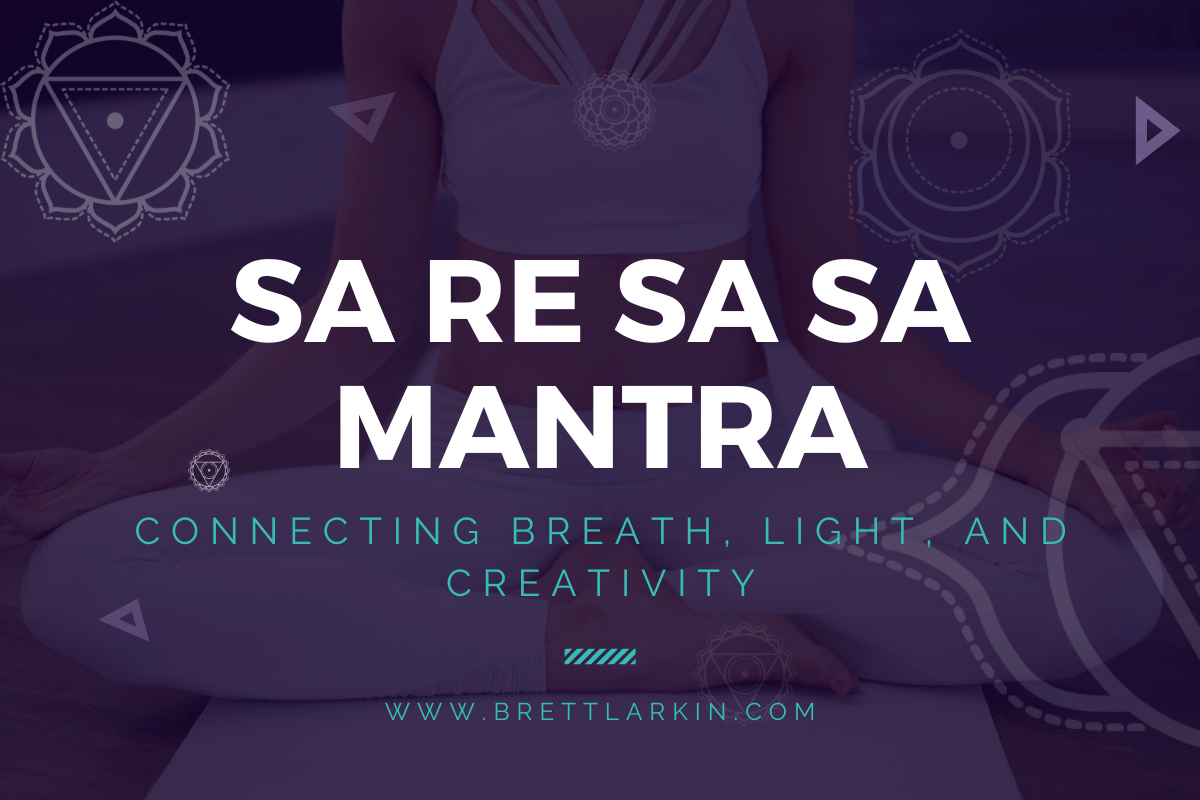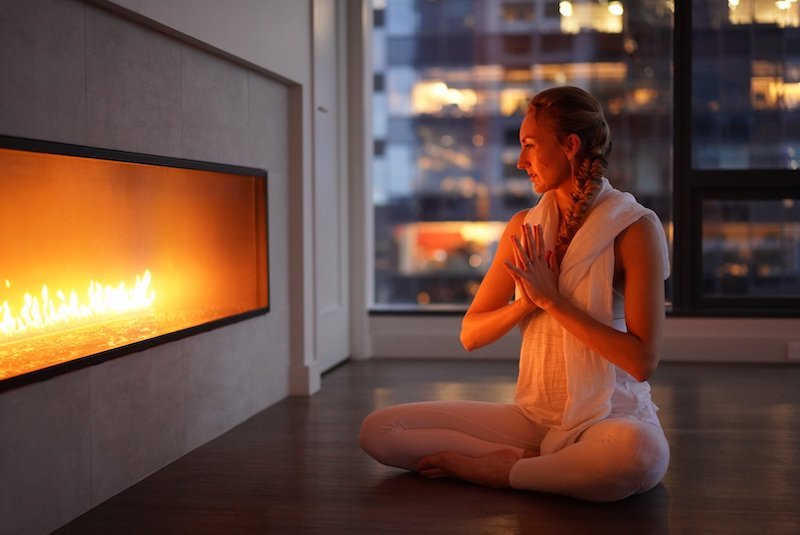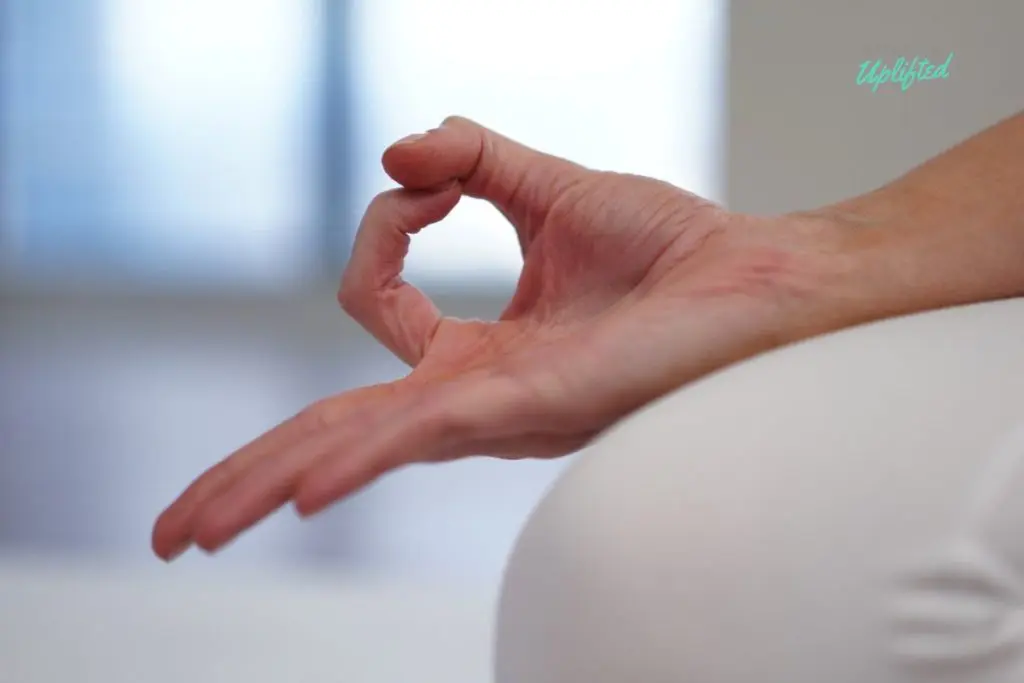Many people in our yoga community have been reaching out to me with questions about the Sa Re Sa Sa mantra. This “beginner level” Kundalini mantra is beloved by many yoga practitioners who incorporate chanting mantras in their practice. Let’s explore why.
Sa Re Sa Sa Meaning
Depending on where you look, the Sa Re Sa Sa mantra may be explained in various ways. This is due largely to the fact that Kundalini yoga has been practiced for so long and teachers of different lineages have passed on their own interpretations and research on this mantra. There are many commonalities but also discrepancies.
Sa Re Sa Sa Mantra
The full Sa Re Sa Sa mantra is:
Sa Re Sa Sa, Sa Re Sa Sa, Sa Re Sa Sa, Sa Rung
Har Re Har Har, Har Re Har Har, Har Re Har, Har Har Rung
(Re is pronounced “ray”.)
Definitions of Sa Re Sa Sa
Kundalini Research Institute Definition
The Kundalini Research Institute (KRI) defines Sa as being the infinite, totality, God. It’s associated with the element of ether. You can think of it as the origin point and that which contains everything else: the beginning, the middle, and the end.
Har is defined by KRI as the creativity of the Earth. It’s a more dense sound, and a dense element that has the power of manifestation behind it. Har is more tangible and personal than Sa, which I agree with.
With Rung at the end of each line of the mantra, the sound of UNG is added. The UNG sound acts to project the sound through the body. It gives the mantra a projective quality.
Additional Sa Re Sa Sa Definitions
Sa means “Infinity is everywhere” and Har means “Creativity is everywhere.” The message of the mantra meaning, “Infinity is everywhere. Creativity is everywhere.”
The use of Re in each line of the mantra acts as a musical connector. It is included in the mantra to connect the sounds and make it easier to sing.
Sa Re Sa Sa Defined by Chakra Exploration
Let’s explore these words in the context of the chakras.
When you chant the word Sa, it feels very upper chakras. Like it is connected with the ether.
Now, try to chant Har. If you are like me, you probably feel this in your abdominals and core, your third chakra. The idea of Har being dense makes sense now, right? And gives a physical example of why this denser sound would be associated with the power of manifestation. Especially given that your third chakra (Manipura), your Solar Plexus, represents your strength, vitality and willpower. It’s what powers you to get things done, to manifest.

Guru Singh’s Definition of Sa Re Sa Sa
I also spoke with Guru Singh, my co-teacher of Kundalini University (our 200 HR Kundalini YTT) to get his interpretation of this beloved Sa Re Sa Sa mantra.
Guru Singh’s approach to this mantra is more physical and human-centered.
Guru Singh relates Sa to the sound of an inhale. This mantra reminds us that Sa, the inhale, is life. Sa is breath. Sa is life.
Ha (Har) takes energy from the Root chakra (Muladhara) to the Crown chakra (Sahasrara). To help this make sense, take a moment and say “Ha” out loud. Feel what it’s doing in your body. You probably notice that it contracts the abdominals and definitely feels like it’s moving energy up the spine.
Guru Singh also associates Ha (Har) as the energy of laughing and crying. Have you ever laughed so hard that it hurt? It’s because the deep laughter, the “ha ha ha” generated a core workout in your body. You also activate your deep transverse abs, core muscles, when you sob. The action of intense, deeply felt crying.
You know how much I’m obsessed with polarity. It is beautiful to see Ha representative of both the energy of laughing and crying. These emotions and actions encapsulate a polarity of emotion and essential humanness.
Finally, we get to Re. Guru Singh defines Re to mean light. The Re, the light, gives the mantra direction.
Also, the use of “R” in both Re and Har distributes the mantra through your myofascial network.
One more time, in Guru Singh’s own words:
“So the most important thing to understand is the direction of the sounds. The direction of Sa is the breath, and the direction of Ha is the energy coming from the root to the crown. Ha is the sound of laughing and crying. And you add the R to it. It takes laughing and crying, takes the sound from the belly and the root at the pelvis and the base of the Kundalini, and brings it up into the heart. Crying asks for help. Laughing offers help. That’s what ha ha is both in laughing and crying, and then you add the R to it, and that takes the sound through the myofascial network of the heart muscles into the tongue muscles to roll the R. So it’s hard, and that’s what takes the laughing and crying into its devotional state, moving the energy from the heart into the head, into the crown, by the tongue trilling off the top of the mouth, the roof of the mouth, and activating the hypothalamus.”
– Guru Singh
What Are The Benefits Of Chanting Sa Re Sa Sa Mantra
Sa Re Sa Sa mantra is widely referenced to be the base mantra of all other ancient mantras. Often, it is recommended that if you want to begin a mantra practice you should start with Sa Re Sa Sa. It’s said to clear the central channel (Sushumna nadi) and to bring you wisdom of the past, the present and the future.
It’s also said to open the chakras. By opening up the flow of energy, any additional mantra you do can have a bigger and fuller effect.
How To Practice Sa Re Sa Sa Meditation
There are two options commonly shared for practicing the Sa Re Sa Sa mantra.
One is meant to be practiced on the Full Moon which is a wonderful opportunity to get in tune with the moon’s cycle and begin a lunar ritual. A bonus to this approach is that while you may start with this base mantra and progress on to others, each month you are invited back to reconnect on the Full Moon and Sa Re Sa Sa can reinforce your open flow of energy.
When practiced at the Full Moon, it is said that this mediation brings peace, security, and the wisdom to make the right choices in life.
Not to be confusing, but both of these Sa Re Sa Sa practices that are outlined below are referred as the Antar Naad Mudra Meditation (Kabadshe Meditation). Just remember to switch up your mudra practice to match the occurrence of a Full Moon.
Before you begin these practices, always Tune In with the Adi Mantra. If you like, you can also include the Mangala Charan Mantra in your Tune In. You can find more of my Tune In tips in my free Refine Your Tune In workshop.
Are You Chanting Correctly? Refine Your Tune with Me! 👇

Are You Chanting Correctly? Refine Your Tune with Me!

“Every Day” Antar Naad Mudra Meditation
Posture: Sit in easy pose (or any comfortable position), spine tall and chin slightly in.
Mantra: Sa Re Sa Sa
Eyes: Closed
Mudra:
- Rest your arms over your legs, hands over your knees/thighs.
- Bring your hands into one of my favorite Kundalini mudras, Buddhi Mudra: fingertips of your thumb and pinky fingers touch. You can also choose to use Gyan Mudra if that appeals to you.
Duration: Whatever you can do is great. It is common to begin with 11 minutes and you have the option to continue for up to 31 minutes.
Antar Naad Mudra Meditation for Full Moon

Posture: Sit in easy pose (or any comfortable position), spine tall and chin slightly in.
Mantra: Sa Re Sa Sa
Eyes: Closed
Movement and Hand Mudra:
- Begin with the palms of your hands touching in Prayer Pose, held at your Navel Point.
- When the mantra starts, slowly raise your Prayer Pose up the center front of your torso.
- When your mudra begins to pass your Heart Center, begin to open your hands to make the shape of an open lotus. To do this, hold the base of your palms together, little fingertips touch, thumb tips touch, and the rest of your fingers are spread open and fingertips reach up. The full open lotus mudra will be formed when your hands reach the level of your Brow Point, or Third Eye (Ajna) and you recite the “Sa Rung” portion of the mantra.
- Flip your hands to form Reverse Prayer Pose, the back of your hands touch and fingers point down. Begin to chant Har Ray Har Har. Slowly bring this mudra down your chakras until your fingertips arrive back at your Navel Point as you recite the “Har Rung” portion of the mantra.
- Return your hands to Prayer Pose and begin again.
Duration: Whatever you can do is great. It is common to begin with 11 minutes and you have the option to continue for up to 31 minutes.
There are many recordings of the Sa Re Sa Sa mantra available for you to use as a guide for these meditations. Two that are often recommended for their rhythm are recordings by Guru Shabad Singh and Nirinjan Kaur. As you begin, listen to the chant for a minute to familiarize yourself with the rhythm and then join in on the mantra.
I invite you to experiment with your chanting volume. Maybe chant at a full out volume one day and in a whisper the next. See how each feels in your body.
Take my quiz to learn if YOUR kundalini energy is awakened 👇
Closing Thoughts
I love the simplicity of this mantra. When you break down the Sa, Re, and Har in this mantra you have the elements of light with Re, creativity with Har, and breath (life) with Sa. Essentially you have light, sound, physicality and breath being invoked. Not to forget the R that’s also distributing the mantra through your whole body. Thinking of the mantra in this way, it is not hard to understand why this mantra is loved for it’s energy clearing claims.
After you practice Sa Re Sa Sa, I recommend you explore some other ancient mantras such as Ek Ong Kar, Wahe Guru Mantra, Adi Shakti Mantra, the Aquarian Mantras, Sat Nam, or Ra Ma Da Sa.
Has all this mantra talk piqued your interest in Kundalini yoga? Learn more about this amazing yoga lineage with me in my course Kundalini Demystified.
Wherever your yoga journey takes you, don’t forget to chant and find your breath each day. Make some time to connect with yourself.
Next Steps
- Love Kundalini? Refine your tune in (the Adi Mantra) with me in this free chanting masterclass.
- Experience my Kundalini Dance Party and elevate your mood in 8 minutes.
- Enroll in my Kundalini Demystified training course. Let’s demystify the “mystery” of this ancient science and INSTANTLY reap the benefits!
Get 3 Free Training Vidoes from our Kundalini University Experience & Certification Program

YOU MIGHT ALSO LIKE
- Tantric Har Chant: How It Fuels Prosperity and Inner Power
- Powerful Mantra for Protection Against Negative Energy and Harm
- The Power of Humee Hum Brahm Hum Mantra for Connection and Healing
- The Sa Re Sa Sa Mantra: Connecting Breath, Light, and Creativity
- What Is The Ajai Alai Mantra In Kundalini Yoga?
- What Is Sat Nam Rasayan? How And When To Practice
- The Meaning Of Ang Sang Wahe Guru Mantra in Kundalini Yoga
- Kundalini Yoga: How To Start A 40 Day Kriya
- Energetic Cord Cutting Ritual For Divine Feminine Energy
- The Ancient Art of Dhauti Kriya in Yoga: Cleansing and Purification
- What Is The Subtle Body? Yoga’s 9th Body
- Nauli Kriya: How To Practice This Cleansing Shatkarma
- Vasti Kriya: 3 Yogic Intestinal Cleanses
- How to Resolve Kundalini Awakening
- Subagh Kriya: What Is It And How Do You Do It?













